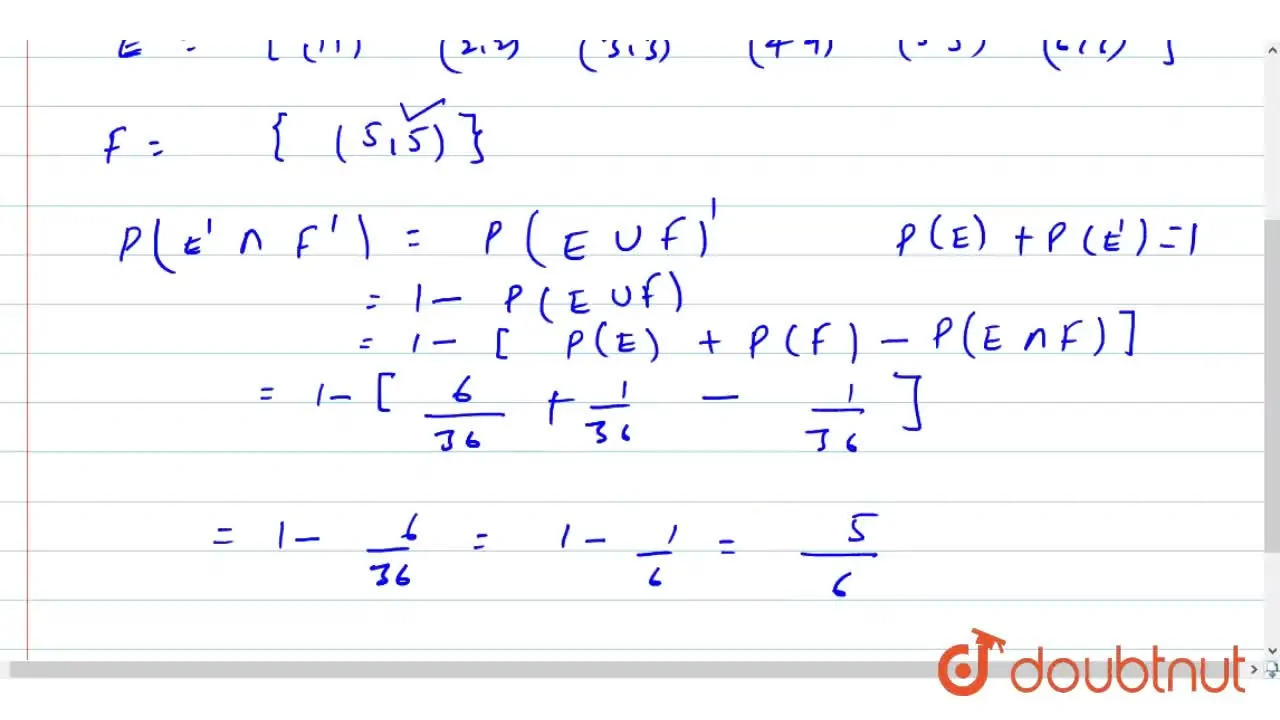Let S be the sample space. ∴ n ( S ) = 36 Let E = event of getting a doublet = { ( 1 , 1 ) , ( 2 , 2 ) , ( 3 , 3 ) , ( 4 , 4 ) , ( 5 , 5 ) , ( 6 , 6 ) } ⇒ n ( E ) = 6 Let F = event of getting a sum of 10 = { ( 4 , 6 ) , ( 5 , 5 ) , ( 6 , 4 ) } ⇒ n ( f ) = 3 Now E ∩ F = { ( 5 , 5 ) } ⇒ n ( E ∩ F ) = 1 ∴ P ( E ∪ F ) = P ( E ) + P ( F ) − P ( E ∩ F ) − 6 36 + 3 36 − 1 36 = 8 36 = 2 9 Now the probability that neither a doublet nor a sum of 10 will appear = P ( ¯¯¯ E ∩ ¯¯¯ F ) = P ( ¯¯¯¯¯¯¯¯¯¯¯ E ∪ F ) = 1 − P ( E ∪ F ) = 1 − 1 9 = 7 9
The correct Answer is:N/a
Let S be the sample space.
∴n(S)=36
Let E= event of getting a doublet
={(1,1),(2,2),(3,3),(4,4),(5,5),(6,6)}
⇒n(E)=6
Let F= event of getting a sum of 10
={(4,5),(5,5),(6,4)}
⇒n(f)=3
Now E∩F={(5,5)}
⇒n(E∩F)=1
∴P(E∪F)=P(E)+P(F)−P(E∩F)
−636+336−136
=836=29
Now the probability that neither a doublet nor a sum of 10 will appear
=P(¯¯¯E∩¯¯¯F)
=P(¯¯¯¯¯¯¯¯¯¯¯E∪F)
=1−P(E∪F)
=1−19=79
Related Playlists
- BOOK - NAGEEN PRAKASHANCHAPTER - PROBABILITYEXERCISE - EXERCISE72videos
PROBABILITY
- BOOK - NAGEEN PRAKASHANCHAPTER - PROBABILITYEXERCISE - MCQ_TYPE20videos
PROBABILITY
- BOOK - NAGEEN PRAKASHANCHAPTER - PRINCIPLE OF MATHEMATICAL INDUCTIONEXERCISE - Exercise 429videos
PRINCIPLE OF MATHEMATICAL INDUCTION
- BOOK - NAGEEN PRAKASHANCHAPTER - RELATIONS AND FUNCTIONSEXERCISE - MISCELLANEOUS EXERCISE12videos
RELATIONS AND FUNCTIONS
Similar Questions
If f={(1,4),(2,5),(3,6)} and g={(4,8),(5,7),(6,9)}, then gof is
View SolutionIf P(E)=0−8,P(F)=0.5 and P(FE)=0.4, then P(EF)=
View SolutionE and F are two independent events. The probability that both e and F happen is 1/12 and the probability that neither E nor F happens is 1/2. Then
View SolutionIf ¯¯¯E and ¯¯¯F are the complementary events of E and F respectively and if 0<P(F)<1, then
View SolutionLet E = {1,2,3,4} and F = {1,2}, then thee number of onto functions from E to F is
View SolutionLet E and F be two independent events such that P (E) > P(F). The probability that both E and F happened is 112 and the probability that neither E nor F happens is 12, then
View SolutionE and F be two independent events such that P(E) < P(F). The probability that both E and F happen is 1/15 and the probability that neither E nor F happen is 8/15. Then P(E) = ____
View SolutionIf E and F are two events such that 0 < P(F)< 1, then
View SolutionFind the mode of the following discrete series.
xf xf15 51224 6336 7948 810View SolutionLet E=(1,2,3,4)andF−(1,2). Then the number of onto functions from E to F is:
View Solution


